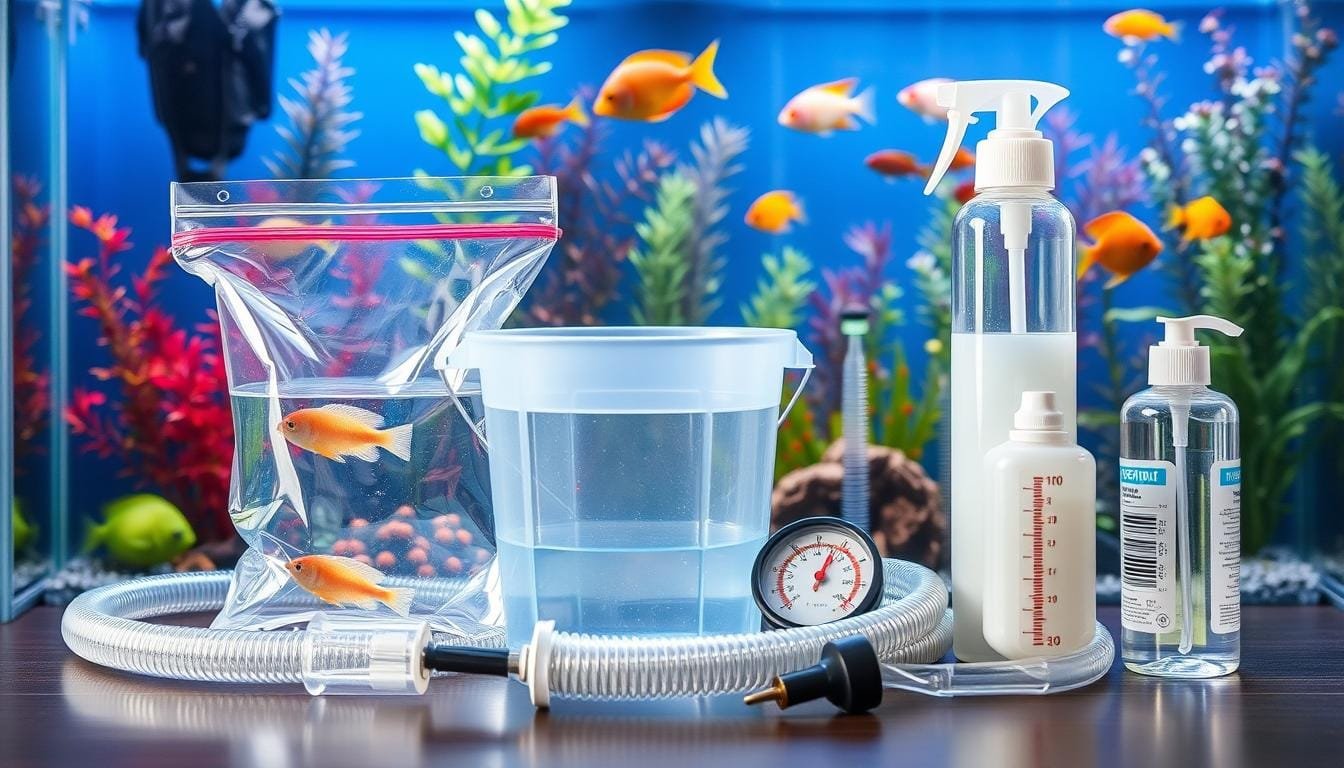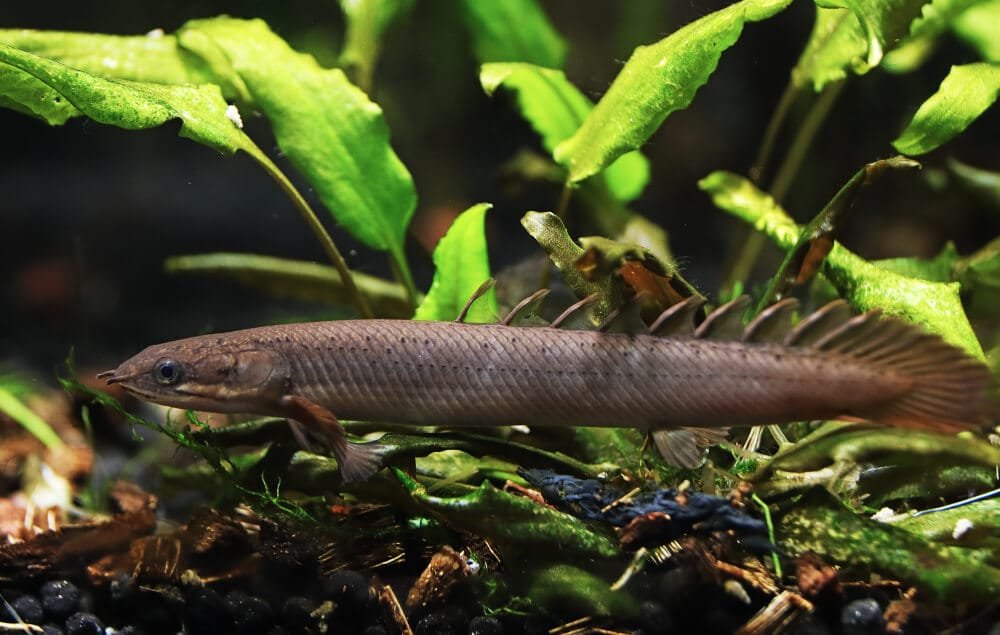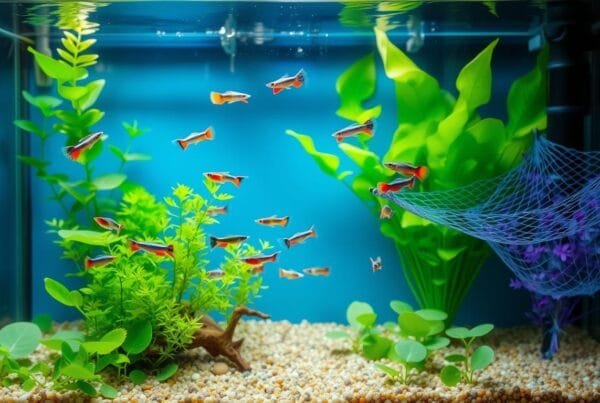Did you know that up to 90% of new fish die in the first week? This is often because they weren’t acclimated properly. Adding new fish to your tank is more than just a simple drop-in.
Setting up a successful fish tank needs careful planning and knowledge of water conditions. Getting acclimation right is key to keeping your fish healthy and alive.
When you add new fish, temperature and water chemistry are very important. Many people don’t realize how stressful moving fish can be. Acclimating them right takes patience, precision, and knowledge.
Experts suggest a step-by-step method for safe fish adaptation. Knowing the right steps can make all the difference for your marine life at home.
This guide will teach you how to acclimate new fish to your tank. You’ll learn about water parameters and best practices. You’ll know how to make your aquarium a welcoming place for your fish.
Understanding the Importance of Fish Acclimation
Adding new fish to your aquarium is a delicate task. It needs careful attention and precision. The acclimation process is key to keeping your fish safe and healthy. If done wrong, it can stress and even kill your fish.
Why Fish Die After Introduction
Fish are very sensitive to changes in their environment. When they’re moved to a new tank, they face many stressors. These can be deadly, including:
- Sudden temperature changes
- pH shock
- Big changes in water chemistry
- Lack of oxygen
“A gradual acclimation can reduce fish mortality by up to 70%.”
Common Acclimation Mistakes
Aquarists often make big mistakes when introducing new fish. Some common errors are:
- Not acclimating slowly enough
- Not checking water differences
- Not watching for fish compatibility
- Skipping the quarantine step
Impact of Proper Acclimation on Fish Health
Acclimating fish carefully can greatly improve their survival chances. Experts say to adjust the temperature by 5 degrees Fahrenheit at a time. The acclimation should take about 45-60 minutes. This lets fish safely adjust to their new home.
With a thoughtful acclimation process, you can create a healthy and happy aquarium. This supports the well-being of your fish.
Essential Water Parameters to Monitor

Keeping your aquarium water in top shape is key for your fish’s health. Aquarium water testing ensures a safe and stable home for your fish.
Here are the main water parameters to watch:
- pH Levels: Very important for fish, most do well between 6.8 and 7.8
- Temperature: Keeping the water temperature steady helps prevent stress in fish
- Ammonia: This toxic waste should always be zero
- Nitrite: Shows there’s ongoing bacterial action in the water
- Nitrate: The last step in water conversion, okay in small amounts
Experts say to test water every 3-4 days when setting up your tank. The nitrogen cycle takes 2-6 weeks to settle. The goal is:
0 ppm Ammonia, 0 ppm Nitrite, and 5-20 ppm Nitrate
Get good test kits to check these parameters right. If ammonia or nitrite go up, do a 30% water change to keep your tank healthy.
The Science Behind Fish Stress and Adaptation
Understanding fish stress is key for a healthy aquarium. Fish have complex reactions when they move to new homes. This makes the acclimation process very scientific.
When fish meet new water and environments, they adapt to survive. Most fish are ectotherms. This means their body processes change a lot with temperature.
Physical Stress Factors
Physical stress affects fish health a lot during aquarium transitions. Important physical stressors include:
- Rapid temperature changes
- Inappropriate handling
- Transportation shock
- Sudden environmental shifts
Chemical Stress Factors
Chemical changes stress fish a lot. During transport, water changes a lot:
- pH levels drop
- Ammonia concentrations increase
- Oxygen levels fluctuate
- Salinity changes
Behavioral Signs of Stress
Fish show stress through behavior. Watching them closely helps spot problems like:
- Rapid, irregular breathing
- Erratic swimming patterns
- Clamped fins
- Reduced appetite
Knowing these stress factors is vital for a safe, comfy home for your fish.
Required Equipment for Acclimation Process
Getting the right gear is key to smoothly adding new fish to your tank. The right tools help ensure your fish get along and reduce stress during acclimation.
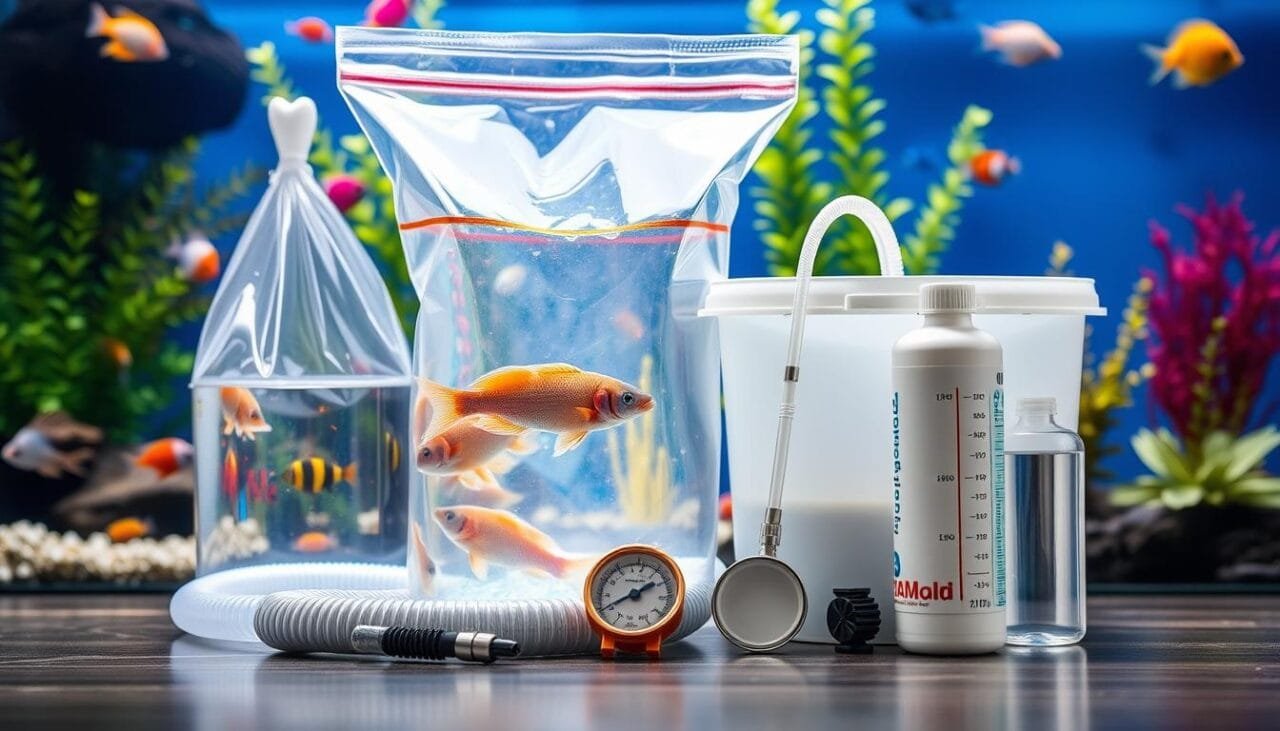
- Large specimen container or bucket
- Soft fish net
- Airline tubing
- Precise thermometer
- Water testing kit
“The right tools make all the difference in creating a smooth transition for your aquatic pets.”
Knowing about water conditions like salinity and hardness is vital. A good water testing kit is essential for checking these important factors during acclimation.
| Equipment | Purpose | Importance |
|---|---|---|
| Specimen Bucket | Temporary holding area | Prevents immediate tank exposure |
| Airline Tubing | Controlled water exchange | Manages drip rate for gradual acclimation |
| Water Testing Kit | Measure water chemistry | Ensures alkalinity and parameter compatibility |
Pro tip: Always have your equipment ready before introducing new fish to minimize stress and maximize survival rates.
Standard Float Method vs Drip Acclimation
When adding new fish to your tank, it’s important to do it right. This prevents stress and health problems. There are two main ways to acclimate fish: the standard float method and drip acclimation.
Comparing Acclimation Methods
Both methods have their benefits. They help watch fish behavior and lower stress from chlorine. Knowing the details of these methods can really help your fish thrive.
| Method | Time Required | Best For |
|---|---|---|
| Float Method | 15-40 minutes | Small to medium fish |
| Drip Acclimation | 30-60 minutes | Sensitive species |
Standard Float Method Steps
- Float sealed bag in tank for 15-20 minutes
- Use dechlorinator to neutralize harmful chemicals
- Gradually add tank water to bag
- Monitor fish behavior during process
Drip Acclimation Technique
- Transfer fish to separate container
- Use airline tubing for slow water exchange
- Adjust drip rate to 2-4 drops per second
- Continue until water volume triples
Proper acclimation can increase fish survival rates by minimizing shock from environmental changes.
Time Requirements
The time needed for acclimation changes based on the fish and how they were shipped. Smaller fish usually adjust quicker. But, bigger or more sensitive fish might need up to two hours.
Choosing the right method depends on your fish’s specific needs. Always go for a gradual introduction and keep a close eye on them. This ensures a smooth move to their new home.
How to Acclimate New Fish to Your Aquarium
When you bring new fish to your aquarium, it’s important to focus on water quality and fish health. The acclimation period is key to reduce stress and help them adjust smoothly.
First, set up a special area for acclimation. Here are the main steps:
- Keep the fish bag sealed and floating in the aquarium for 15-30 minutes
- Maintain a consistent temperature around mid-70°F
- Create a dim or dark environment to reduce stress
- Monitor for signs of distress during the process
“Patience is key when acclimating new fish to their environment” – Aquarium Experts
The drip acclimation method is the most gentle way to introduce fish. Follow these steps:
- Use a clean bucket dedicated to fish acclimation
- Set up a slow drip rate of 2-3 drops per second
- Gradually introduce aquarium water to the transport bag
- Aim to replace at least half the original water volume
Look out for signs of stress during acclimation, like:
- Gasping at the water surface
- Erratic swimming patterns
- Rapid breathing
- Sudden color changes
Acclimation usually takes 30-45 minutes. If you see severe stress, remove the fish and watch them closely. Remember, each fish species may need a different acclimation method.
Managing Temperature and pH Differences
Introducing new fish to your aquarium needs careful attention to water temperature and pH levels. Fish are very sensitive to changes in their environment. Moving them from their bag to your aquarium is a critical step.
It’s important to understand the risk of shock. Even a small difference in water temperature can stress fish a lot. The time they spend floating in the bag helps reduce this risk.
“Patience during acclimation can mean the difference between a thriving and a struggling aquarium ecosystem.”
Key Acclimation Considerations
- Monitor bag temperature carefully during the floating process
- Allow 15-20 minutes for initial temperature equalization
- Check pH levels before introducing fish to prevent shock
- Gradually mix tank water with bag water
| Parameter | Safe Range | Risk Level |
|---|---|---|
| Temperature Difference | Within 2-3 degrees | Low |
| pH Variation | Less than 0.5 units | Low |
| Temperature Shock | More than 5 degrees | High |
Pro tip: Use a reliable thermometer to track water temperature precisely during the acclimation process. Slow and steady wins the race when introducing new fish to your aquarium.
Remember, achieving balance in your aquarium takes time. Hurrying the acclimation can stress or even kill your fish. Be patient, observe closely, and your new fish will thrive.
Quarantine Procedures for New Fish
When you bring new fish to your aquarium, you need to be careful. Quarantine procedures help keep your fish healthy and safe from diseases. This is key for the well-being of both your new and existing fish.

A quarantine tank is the first step in introducing new fish. It’s a controlled space where you can watch the fish and stop diseases from spreading to your main tank.
Setting Up Your Quarantine Tank
Setting up a quarantine tank is important. Here are some things to consider:
- Choose a tank size between 10-20 gallons
- Use a bare-bottom tank for easier water testing and cleaning
- Install a reliable sponge filter with media from an established tank
- Maintain stable water parameters matching native conditions
Quarantine Duration and Monitoring
Experts say to keep new fish in quarantine for 4-6 weeks. This lets you check their health. Use a good test kit to monitor water changes and keep it healthy.
“Proper quarantine can save your entire aquarium from disease outbreaks” – Aquarium Health Specialist
Treatment Protocol
Here’s a plan for treating new fish:
| Medication | Dosage | Duration |
|---|---|---|
| Maracyn | 1 packet per 10 gallons | 7 days |
| ParaCleanse | 1 packet per 10 gallons | 7 days |
| Ich-X | 1 teaspoon per 10 gallons | 7 days |
Note: Always follow the instructions on the medication and don’t feed fish during treatment.
By following these steps, you can keep your aquarium safe from diseases. This way, your new fish can adjust and grow well in a healthy environment.
Special Considerations for Different Fish Species
Acclimating fish isn’t the same for every species. Each one needs a special approach to avoid stress and shock. Fish like discus and wild-caught ones need extra care when moving to a new tank.
Knowing what each fish species needs is key to their success. Proper acclimation techniques help avoid shock from temperature and pH changes.
- Tropical fish often require slower temperature adjustments
- Marine species need precise salinity matching
- Wild-caught specimens are more susceptible to shop water changes
*Patience is the key to successful fish acclimation*
Fancy plecos and delicate marine species might need longer to acclimate. Keeping a close eye on water conditions is important. This helps avoid stress that could harm their health.
By understanding each species’ needs, aquarium lovers can make the transfer process better. This ensures a smooth start in their new home.
Introducing Fish to the Main Tank
The final step in fish acclimatization needs careful attention and gentle handling. A smooth introduction helps reduce stress and ensures a good start in their new home.
Proper Release Techniques
When adding new fish, follow these important steps to avoid water problems:
- Float the sealed fish bag in the aquarium for 15-20 minutes to equalize temperature
- Use a small net for transferring fish to prevent water volume contamination
- Keep aquarium lights dimmed to reduce initial stress
- Avoid releasing bag water directly into the main tank
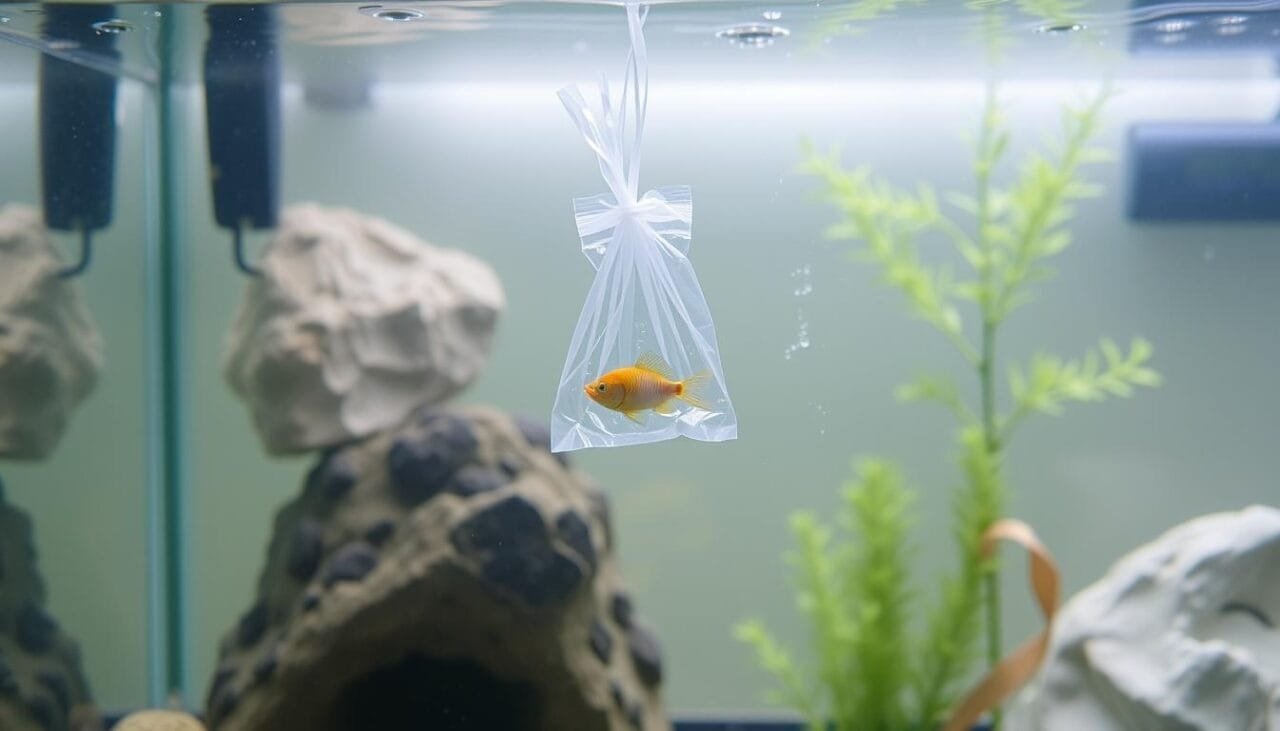
First Feeding Guidelines
The first meal is key for adjustment. Give small, easy-to-digest food to help new fish get used to the water. Here’s how to do it right:
- Wait 1-2 hours after introduction before first feeding
- Provide minimal food quantities
- Observe fish eating behavior carefully
Monitoring New Fish Behavior
Look for signs that show they’re adjusting well:
- Normal swimming patterns
- Active exploration of tank areas
- Regular breathing
- Interaction with tank environment
“Patient observation is key to ensuring your new fish integrate smoothly into their aquarium home.”
Remember, each fish species might need a different introduction plan. Being patient and watching closely will help reduce stress during this important time.
Common Acclimation Mistakes to Avoid
Aquarium lovers often make big mistakes when introducing fish. These errors can lead to a lot of fish dying. Knowing these mistakes can help keep your fish safe from transport stress and shipping problems.
“Up to 70% of hobbyists neglect proper acclimation procedures, risking their fish’s health and tank ecosystem.”
Here are some key mistakes to avoid for better fish survival:
- Rushing the drip rate during water parameter adjustment
- Skipping the compatibility check between new and existing fish
- Neglecting to match water source parameters
- Failing to quarantine new fish specimens
Some of the most serious mistakes include:
| Mistake | Potential Consequence |
|---|---|
| Rapid temperature changes | Immediate physiological shock |
| Ignoring pH differences | Increased fish stress and mortality |
| No quarantine procedure | Risk of disease transmission |
Professional aquarists suggest a minimum 4-week observation period for new fish. This helps assess their health and reduces risks during introduction.
By knowing these common mistakes, you can make a safer space for your fish. This reduces stress from shipping and helps them settle into their new home better.
Conclusion
Keeping fish healthy starts with acclimation. With 60% of new fish failing, your net transfer and quarantine tank care are key. A good acclimation plan can boost survival rates to 95%. This makes your aquarium a lively underwater world.
Watching your fish closely is important. Studies show dim lights and slow release methods help reduce stress. Using the drip acclimation method, with 2-4 drips per second for 45-60 minutes, greatly increases their chances of adapting well.
Understanding water and temperature is vital. Experts say each step in acclimation is an investment in your tank’s health and beauty. A careful approach can overcome challenges and create a peaceful underwater home.
FAQ
How long does the fish acclimation process typically take?
Acclimation usually takes 30 minutes to an hour. It depends on the fish and water differences. The drip method takes 45-60 minutes, while the float method is 15-30 minutes. Always be patient and slow to avoid stressing your fish.
Can I skip the acclimation process if the fish look healthy?
No, you should never skip acclimation. Even healthy fish can die from sudden water changes. Changes in temperature, pH, and chemicals can shock fish, leading to death or stress.
Do I need a separate quarantine tank for new fish?
A quarantine tank is not required but highly advised. It stops disease spread, lets you watch the fish’s health, and helps them adjust to their new home. A 2-4 weeks quarantine is usually recommended.
What’s the difference between the float method and drip acclimation?
The float method involves floating the bag in the tank to match temperatures, then adding tank water slowly. Drip acclimation uses a slow drip to add tank water, adjusting parameters more carefully. Drip acclimation is better for sensitive fish.
How can I tell if my fish is experiencing stress during acclimation?
Look for signs like rapid breathing, clamped fins, and erratic swimming. Also, check for loss of color, hiding, or staying at the surface or bottom. Other signs include reduced appetite and unusual behavior.
What water parameters should I check before introducing new fish?
Check temperature, pH, ammonia, nitrite, nitrate, hardness, and alkalinity. Use a test kit to match the fish’s original water as closely as possible. Each fish species has its own ideal parameters.
How often should I check on new fish during the acclimation process?
Check on your fish every 5-10 minutes during acclimation. Watch their behavior, breathing, and overall health. After introducing them to the main tank, observe them closely for 24-48 hours.
Can I acclimate multiple fish at the same time?
Acclimating multiple fish at once is possible but not recommended. It’s better to acclimate them individually or in small groups. This way, you can monitor them more closely and reduce stress. If you do acclimate multiple fish, make sure they are from the same species or have similar water needs.
